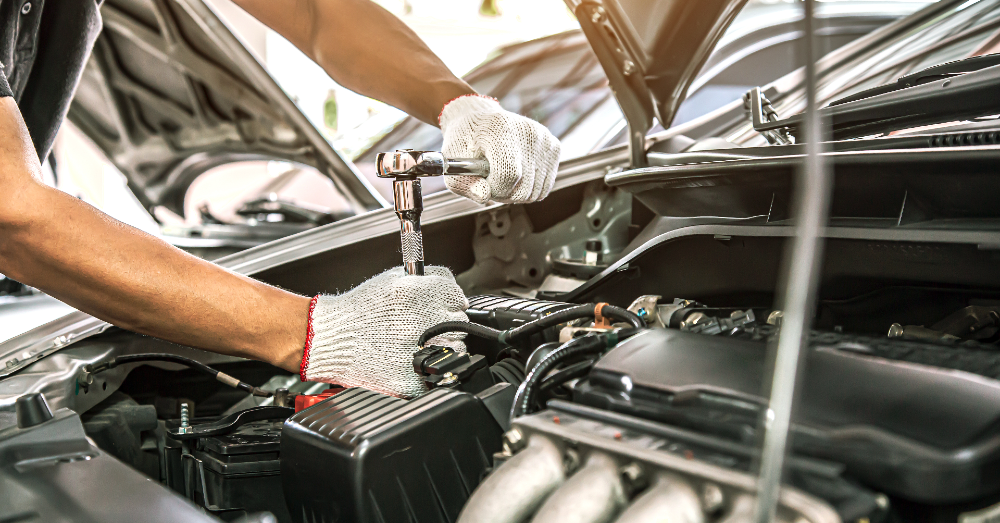Vehicle maintenance is a must to keep your vehicle running as it should. While it can be a hassle to book an appointment and take the time out of your day to get your vehicle serviced, professional service ensures your vehicle stays in the best shape possible.
Luckily, there are some maintenance jobs you can do on your own. Today, we’ll take a look at five vehicle maintenance tasks that require little effort, and five you’ll be better off having a mechanic work on.
5 Tasks You Can Do at Home
The following five vehicle maintenance tasks are easy, straightforward, and are beginner-level tasks. When in doubt, consult a demo video and see just how easy they are to do!
1. Changing Spark Plugs
If you notice your vehicle has issues starting or misfiring when you turn the engine over, it might be time to change out your spark plugs. You can change the spark plugs at home on your own, but you’ll need the necessary tools. You’ll need to have a socket wrench, your spark plug socket, your spark plug gap tool, a torque wrench, and paper towels. Watch a couple of demo videos, and discover just how easy it is to do this service on your own!
2. Replacing an Air Filter
An often overlooked maintenance service is changing out the cabin air filter. You should replace your vehicle’s air filter every 15,000 and 30,000 miles. Using your vehicle’s manual, locate the cabin filter cartridge, open it, and remove and replace the filter. Yes, it’s really that simple!
3. Changing the Oil and Oil Filter
Changing the oil and oil filter in your vehicle is a necessary maintenance task to keep your engine running strong. It takes a little time, energy, and research to understand how to change your oil the right way. But once you learn about the process beforehand, you’ll be surprised at just how easy it is to change the oil and oil filter all on your own.
4. Replacing Your Windshield Wipers
If your windshield wipers are going bad, looking up your wiper measurements and getting replacement parts at your local auto parts center is as easy as it sounds. What’s easier than finding the right wipers? Installing them on, of course! If you’re not quite sure how to do it, ask an associate at your local auto replacement shop. Most shops will help you replace them free of charge, or at the very least show you how to do it yourself.
5. Checking and Replacing Fluids
Sure you can take your vehicle to your local car dealership for fluid inspection and top-offs, but with a little bit of research, this is something you can do in minutes right in your garage. While most vehicles have the same typical layout and requirements when it comes to fluids, consult your user manual to see where fluid components are located and what recommended levels are. Typically, you’ll want to check the levels of your oil, your coolant, your washer fluid, and even your battery fluid levels.
5 Auto Issues You Should Take to a Mechanic
The DIY jobs we’ve listed above are beginner-level, easy to execute, and can save you time, energy, and money. However, not all vehicle maintenance services are that easy. Here are some jobs you should absolutely take to a mechanic in order to make sure they are done right.
1. Brake System Repairs
Your brake system is one of the most important functions of your vehicle. If you experience issues including squeaking, grinding, or ineffective responsiveness when you hit the brakes, it’s best to let the pros assess the issue. If you need a brake replacement or have other major issues identified, let the specialized technician remedy and repair the issue.
2. Transmission Repairs
Attempting to repair a transmission if you don’t have the experience could cause you to do more damage than good. Your transmission is installed alongside other critical components in your vehicle including your engine. Tampering with one part of your transmission could cause you to create other issues with different components of your vehicle. Transmission repairs are complex, require specialized tools, and demand the expertise of a professional. Even if you have some relative experience it’s best to bring your vehicle in where a specialized tech can diagnose and repair the issue.
3. Suspension and Steering Issues
As with your brake system, trust the experts to handle suspension and steering issues. If you’re noticing things like a bumpy ride, misalignment, or poor suspension, book a service appointment with a trusted mechanic.
4. Engine Repairs
Your engine is the heart of your vehicle, and you’ll want a professional who knows what they’re doing to work on it. If you suspect an engine issue with your vehicle, there are a variety of things that could be the culprit. And while you may be able to diagnose the issue, it’s a whole different game trying to remedy it.
Bringing in your vehicle to a mechanic means you’ll have someone who has access to diagnostic tools that can give your engine a thorough analysis. Plus, you can be sure a certified mechanic won’t void any existing warranty if they work on it. Engine repairs and rebuilds are highly complex and specialized and require a variety of tools that you probably don’t have on hand to begin with. Save yourself the hassle and let the pros work on any engine issues you may be having.
5. Electrical System Repair
Trying to fix an electrical issue with your vehicle could lead you to bring down the whole system. Skip the headache and hassle and let a mechanic work on issues with your vehicle’s electrical system.
Final Thoughts
Maintaining a vehicle doesn’t have to be hard work. Having an understanding of what you can and cannot DIY on your own is the best way to make sure your vehicle stays in the best shape possible.




